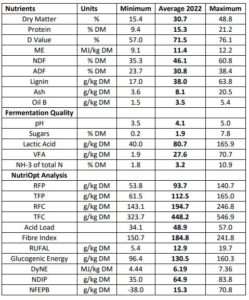Silage Watch Early 1st Cut
For the season so far (early May to mid-June) 529 samples have been analysed by the Trouw Nutrition GB Laboratory, this data represents those farmers taking an earlier first cut. There will be a split between farmers cutting earlier in the season and those going later depending upon their individual objectives. Given concerns over fertiliser price and availability some farmers may opt for fewer, but more bulkier cuts, where others still remain with a multi/ Opti cut system. It is important to remember the mild winter preceding this silage season which could severely impact silage quality. Those silages containing a higher proportion of overwintered material may be more fibrous and less digestible.
Early 1st Cut Averages
- Dry matter in this sample set is 3% lower than last year’s early first cuts at 30.7% DM.
- Crude protein is higher at 15.3% DM, which was seen in pre-cut data this year.
- This has led to slightly higher levels of fermentable protein and metabolisable protein available to the cow.
- The most notable difference between the 2022 and 2021 season is in the fibre. Due to a mild winter and prolonged growth NDF has increased; 46.1% DM vs. 41.8% DM in 2021.
- Over 50% of analysed samples have a NDF value of over 45% DM, coupled with a high lignin value this leads to reduced digestibility and lower dry matter intakes.
- In comparison to 2021, this year’s energy is slightly lower in ME (11.4 vs. 11.7 MJ/kg DM); where there is a large range in DyNE (dynamic net energy) which is the energy available to the cow.
- Those forages high in DyNE have a more digestible fibre, whereas those that are lower in DyNE have higher lignin and undigestible proportions of the plant.
- The less digestible crop does however promote good rumen health with a low acid load and high fibre index. Careful balancing of both rapidly and slowly fermentable carbohydrates and proteins will promote good milk production. Typically ground cereals introduce rapidly fermentable carbohydrates (RFC) and will support the more fibrous forages.
- Good levels of protein will help to balance the rumen, but some rumen fermentable protein will be required to support where there is excess fermentable carbohydrate. Balancing the rumen will promote, increased fibre digestion, improved throughput, optimal microbial protein yield and improved intakes and efficiency overall.
Summary
The samples represented here are from those farmers who took an early first cut. Subsequent cuts may be of lower quality or more variable given the changeable weather.
It is important to get individual clamps analysed frequently. This season the key to optimising animal performance will be balancing the rumen in terms of fermentable carbohydrates and proteins to get optimal throughput, fibre fermentation and performance.

